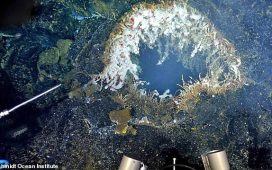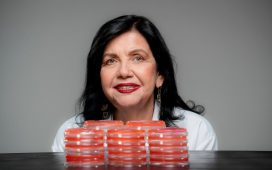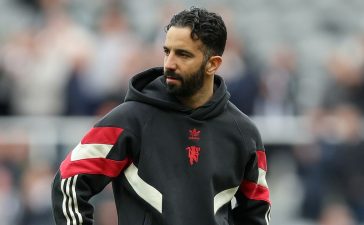Four kilometres into his 242nd parkrun and Richard Scolyer is full of enthusiasm.
“This is great, Kate!” he calls to his wife, Katie Nicoll, behind him.“Thirty-five minutes and we’ve got 1km to go.”
Scolyer, 58, is setting the pace for the couple and a stream of friends who join him for stretches of the 5km run along Hawthorn canal, in Sydney’s inner west, on a fresh Easter Saturday morning.
They jog for 500 metres, and then, after a beep from Scolyer’s watch, walk for 500 metres. Nicoll would happily have the walking sections last a little longer – “I’m not a runner,” she says wryly – but Scolyer pushes his group along.
“A bit further and then we’ll walk for a bit,” he calls back.
For Scolyer, a 5km parkrun would be a fairly minor feat compared with some of the athletic challenges he has taken on, were it not for the circumstances.
The endurance athlete, who has represented Australia at the World Triathlon Multisport Championships, has only just been cleared to jog by his medical team, after brain surgery last month. The surgery – his second in two years – was to investigate the recurrence of a brain tumour he was first diagnosed with in May 2023.
The recurrence of the cancer, grade 4 IDH-wildtype glioblastoma, has given him a “short timetable to live”, he says. “I don’t know, no one can really predict it.”
How is he feeling today? “Oh, pretty good. You know, to be truthful, I can feel little bits and pieces that are happening. How much of that is related to the treatment I’m having, how much of it’s related to the disease recurrence? I guess in reality it’s likely to be both of those things happening at the same time.
“I get scared at different times of how long I’ve got left and poor Katie has to put up with me getting grumpy.”
“Oh rubbish,” she says affectionately.
At the beginning of 2024, Scolyer and Prof Georgina Long, who were joint directors of the Melanoma Institute of Australia at the University of Sydney, took the mantle of joint Australians of the Year, in recognition of their pioneering work developing immunotherapy treatment for melanoma. This treatment has increased survival rates from 5% to 55% for patients with metastatic melanoma over the past 20 years.
But for the treatment of brain cancers like his, very little progress has been made in decades.
“The thing about brain cancer is there’s nothing that’s proven that works on top of the treatments that started 20 years ago, so it brings grief to everyone,” he says.
After Scolyer’s diagnosis, his colleagues swung into action, with Long developing a targeted form of immunotherapy for Scolyer, which he received prior to surgery. Immunotherapy had never been used pre-operatively for brain cancer before and came with considerable risk. Scolyer says he was told that having the treatment could reduce his survival rate by 50%.
“So to go down this risky path, I’m sorry, I’m getting emotional thinking about it,” he says. “It’s been shown to make a big difference in many other cancers … So it’s risky, but it felt right to me … There was no proof that it was going to work, but I had hope.”
He doesn’t regret trying the experimental treatment, saying he’s been told by experts that it may have been another 10 years before pre-operative immunotherapy may have been trialled on someone with brain cancer had he not been willing to try it.
“Who knows whether it’s made a difference in one patient. There’s certainly hope there, but ultimately you need a clinical trial with groups of patients that prove something works before you can go on and try it in a bigger group of patients. And that’s what’s planned.”
Before the recurrence, Scolyer set himself the goal of 250 parkruns. Easter Saturday marks his 242nd.
Two of his and Nicoll’s three children – Emily, 21, and Matt, 19 (the couple also have 17-year-old Lucy) – are in attendance, running with their friends, as is the family dog, an enthusiastic brown cavoodle named Cha Cha.
The Haberfield run is his local and he is a clearly beloved member of the community: his jog is punctuated by cheers of encouragement from passing runners, and before the race starts, Scolyer corrals the runners into a 400-person selfie.
The warmth from the community has a lot to do with Scolyer’s openness in sharing what he has been through. At a time when he would be forgiven for retreating from public view, Scolyer did the opposite, posting on social media about his diagnosis, treatment and life.
Initially, he says, this was primarily to keep friends and colleagues around the world updated on how he was doing and to keep a record for his kids.
“I was worried, in 10 years time … my kids, how would they remember me? I felt like I wanted to leave a message.”
But his story resonated. Scolyer gets stopped in the street by strangers wishing him well most days.
“I’ve been surprised how many people are interested,” he says. “Honestly, I feel very touched that so many people want to reach out.”
“A lot of people have a cancer story,” Nicoll adds. “I think in a way it gives a voice to what they’re going through, what they’ve been through, and there’s some sort of comfort that people can bring each other.”
It feels discordant, talking about illness and death in the bright April sunshine, surrounded by laughing people in exercise gear.
Right before the race starts, he reflects on the different parts of his life – a meaningful career, a family he adores, friends and hobbies. “I’d squeeze it all in,” he says. He doesn’t regret that. “We never get [the balance] perfect, but I think they’re all very important parts of your life and you should enjoy them.
“None of us are here forever, you never know what’s around the corner. With this sort of cancer, I feel fortunate to still be here … whether that’s related to the treatment I’ve had or it’s just a fluke, no one knows the answer until a proper clinical trial’s been done, but I feel fortunate to still be kicking around.”











